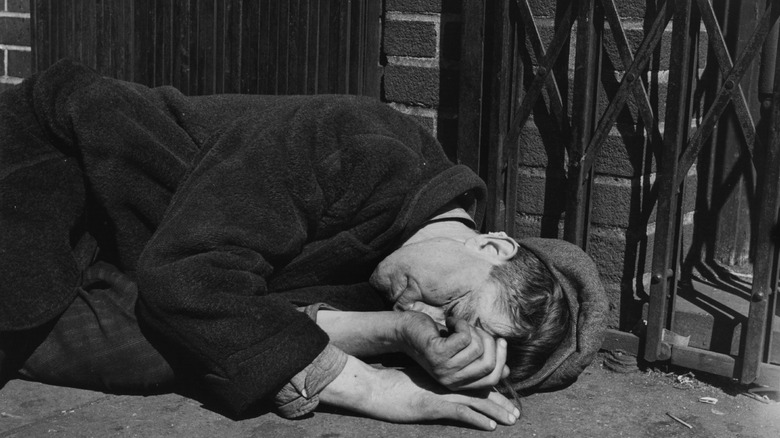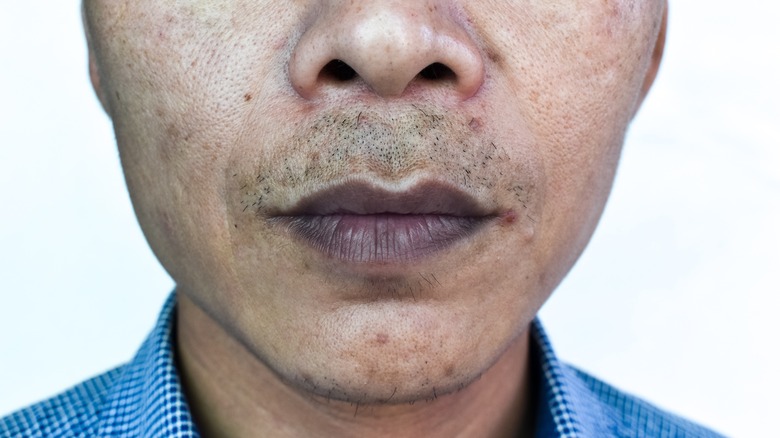11 Different Men Turned Blue Thanks To Toxic Oatmeal
Food poisoning is one of those things that Americans, if they're lucky, only have to deal with on rare occasions. Sanitation and food preparation have come a long way over the centuries, and in general, it takes a major error on someone's part for a plate of food with pathogenic microorganisms on it to wind up in your mouth. Regulations and periodic inspections at many steps of the process — the farm where the food you're eating is grown/raised, the factory where it's processed, the kitchen where it's prepared, the grocery store where it's sold — are in place to minimize the risk.
Regardless, about one in six Americans are sickened by food poisoning each year (per FoodSafety.gov), and though most cases are mild, a few thousand Americans die each year from tainted food. Back in the 1940s, as The New Yorker reported at the time, New York City saw an exceptionally-acute and extremely-rare case of mass food poisoning. Eleven men, all of them elderly vagabonds, ate tainted oatmeal and, for their efforts, came down with a horrible illness that temporarily turned their skin blue.
The 1940s Were a Different Time
These days, New York City is one of the most impossibly-expensive cities in the world to live in; in June 2022, Fortune ranked it as the second-most expensive city in the world, in terms of cost of living, after Hong Kong. Back in the 1940s, things might have been slightly better, depending on how you define "slightly" and "better." Sure, the city had its share of homeless people, but those who could scrape together enough spare change could get a night in a flophouse or a cheap hotel, although in some cases, the line between sleeping on the street and sleeping in the "comfort" of the hotel was a thin one indeed. Overcrowding, lack of sanitation, and other issues bedeviled such places.
One place that housed New York's forgotten was the Eclipse Hotel. Field epidemiologist Ottavio Pellitteri described it to The New Yorker as "strictly a horse market, and dirtier than most," using a quaint 1940s euphemism to describe the place as impossibly disgusting. Nevertheless, the people who lived there could find shelter as well as a meal for a few pennies. Unfortunately, the building's Catering department was less than conscientious when it came to sanitation, and a mistake by a cook led to the horrific sickening of 11 residents.
Acute Cyanosis
On the morning of September 25, 1944, a police officer came upon an elderly man laying on the street, doubled over in pain (via The New Yorker). The cop might have at first thought he was just a drunk sleeping it off, but on closer inspection, the officer found that the man was bright blue; he was suffering from cyanosis, the result of a lack of oxygen in the blood supply, and a serious medical issue. He was taken to a hospital. Over the next several hours, 10 more elderly men were admitted to New York City hospitals, all showing the same symptoms, the most striking of which was the cyanosis that had turned them bright blue (per The Vintage News). All except one would recover, however.
The thread that linked all 11 men together was the Eclipse Hotel and, in particular, the cafeteria there. After some investigation, authorities learned that the cook — in a kitchen that had racked up multiple sanitation violations by that time — had made a mistake when preparing oatmeal that morning. He'd inadvertently thrown in sodium nitrite, a toxic chemical that had been used as a preservative. Further still, some of the chemical was in one of the cafeteria's salt shakers. Long story short, while multiple other people ate the tainted oatmeal that day, only the 11 sickened men had salted it with adulterated salt, pushing the amount of poison in their food over the threshold that would make them sick.


